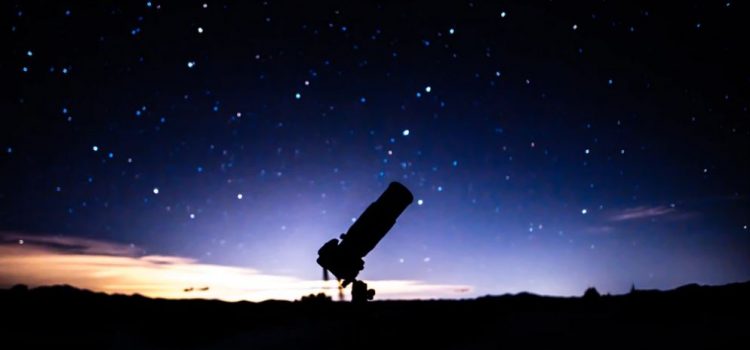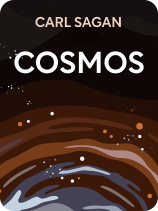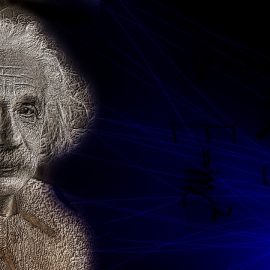

This article is an excerpt from the Shortform book guide to "Cosmos" by Carl Sagan. Shortform has the world's best summaries and analyses of books you should be reading.
Like this article? Sign up for a free trial here .
What does the history of astronomy look like? What is the birthplace of science?
In his book Cosmos, Carl Sagan outlined the history of astronomical thought, from 600 BC to the 17th century. He tells the story of how Thales of Miletus broke the status quo by rejecting the supernatural all the way up to Newton’s discovery of gravity.
Here’s a brief timeline of the history of astronomy.
History of Astronomical Thought
Humans in all places and times have been fascinated by the skies. We’ve used the stars to guide us, to mark the passage of seasons, and make sense of our place in the world for as long as we’ve existed. But our understanding of the nature and order of the universe, and our place in it, has evolved substantially over time. Sagan gives a historical picture of how humanity developed its beliefs “from chaos to cosmos.”
In this article, we’ll briefly outline the Western history of astronomy, as presented by Sagan, from Thales of Miletus in ancient Ionia, to Isaac Newton in 17th-century England.
The Ionian Awakening
Sagan’s history begins between 600 and 400 BC, when a revolution of scientific thought occurred in Ionia, a Greek settlement on the Aegean coast in what is now Turkey. Ionia is often considered the birthplace of science, in the Western tradition. This revolution was sparked by a scientist named Thales of Miletus, who Sagan says was the first known scientist bold enough to attempt to explain the world without appealing to the supernatural. He explains that this had far-reaching consequences, as it prompted a shift from a world made by gods to a world made by natural processes.
| The Natural and the Supernatural Naturalism is the philosophical theory that everything in the world is natural and can be understood scientifically without supernatural explanations. Thales of Miletus is often considered the “grandfather of naturalism.” Other ancient Greeks adopted this approach to the world as well, though some of them, including Thales, still conceived of the natural world as possessing mystical qualities, or having an underlying mind-like intelligence. However, others, like Democritus, rejected ideas of any intelligence or spiritual essence in nature. He and others in this school of thought, called atomists, conceived of the natural world as strictly material and inanimate, and operating on mechanistic principles (this falls into the category of a materialist worldview). Over the next 2,000 years we see a history of debate and tension between this worldview and one that invokes a supernatural creator. In recent history, scientists in fields like biology and ecology are coming to a consensus that the natural world is indeed imbued with intelligence. Animals, plants, and even bacteria are now known to learn, remember, and communicate in ways we were previously unaware of. While none of this implies a supernatural creator, it certainly implies something other than the cold, mechanistic view of strict materialism. |
Sagan details the revolutionary discoveries made during this time, including the idea that the sun was the center of the universe (heliocentric), rather than the Earth (geocentric). Copernicus is often given credit for the heliocentric model of the universe. However, Sagan says that Aristarchus is the first person known to have proposed that the Earth revolves around the sun, in Ionia, in 280 BC, 1800 years before Copernicus. Therefore, he points out that Galileo described Copernicus as “restorer and confirmer” of this worldview, not the originator of it.
Scientists in this period also proposed that the orbits of the planets were elliptical rather than circular, and that gravitational forces were at work in their orbiting of the sun.
(Shortform note: Sagan takes a Western historical perspective in the timeline he presents. In fact, the earliest known suggestion that the Earth revolves around the sun comes from an ancient Vedic text from India. An Indian astronomer named Yajnavalkya, proposed the heliocentric model of the universe around 800 BC, more than 500 years before Aristarchus. In that text, he states, “The sun strings these worlds—the earth, the planets, the atmosphere—to himself on a thread.” It’s unclear why Sagan doesn’t acknowledge this, which leaves us to question whether it’s because of a bias toward Western history or if he was unaware (or skeptical) of this text.)
According to Sagan, Aristarchus’ “great legacy” is the argument that we’re not special. He argued that humans are not the center of the universe, nor is our planet. This idea can be extended to many aspects of life—Aristarchus challenged the prevailing anthropocentric (“human-centered”) worldview. Sagan explains that this was a bold challenge to the social order, as it conflicted with a religious worldview that asserted that humans are uniquely created by the Gods, as well as with the idea of natural social hierarchies.
(Shortform note: Challenging an anthropocentric worldview isn’t necessarily in contradiction with all religions. Most indigenous religions are animistic belief systems that see humans as a part of the natural world just like everything else. These belief systems don’t assume humans are superior to, or have dominion over, anything else in nature, and put a strong emphasis on respect and honor for all non-human beings.)
Alexandria
By the 3rd century AD Alexandria, Egypt had become the new center of scientific inquiry in the West. Around 285 BC, the Great Library of Alexandria was established as the world’s greatest repository of scientific knowledge and literature, though Sagan laments that most of the documents were lost when it was destroyed. He says that he has often wondered where we might be today (scientifically) if all of that knowledge hadn’t been lost.
(Shortform note: The Great Library of Alexandria is believed to have contained in its collections over half a million written works on every subject of human knowledge and inquiry, from cultures across the world. Some scholars believe the Library was burned to the ground in 48 BC during Julius Caesar’s occupation of Alexandria, while others believe it suffered a more gradual destruction due to long periods of political unrest in the area. There is evidence that the buildings were converted into churches and mosques at different periods. Whatever the case, the vast majority of the Library’s contents have been lost to history.)
Sagan explains that it was in Alexandria that Eratosthenes (276-194 BC) made the discovery that the Earth was round. And although this was resisted by many at the time, he points out that it was crucial knowledge for an accurate scientific understanding of how the celestial bodies operate, as well as solidifying a view of Earth as one among other spherical celestial bodies. This also paved the way for explorers who would brave the circumnavigation of the globe centuries later.
However, Sagan explains that much of the astronomical theory coming out of this time period was rejected in favor of the more-accepted Ptolemaic worldview. Ptolemy (100-170 AD), maintained that the Earth was the center of the universe, and the sun, moon, other planets, and stars moved around it, attached to invisible spheres. This model, Sagan says, was ultimately supported by the Church in the coming centuries, and because of that institution’s powerful reach, the Ptolemaic model lingered through the Middle Ages.
| Astronomy During the Middle Ages Sagan’s timeline skips from around the time of Ptolemy to the 16th century. The large gap in history is often attributed to the suppression of science in the Western world by the Roman Catholic Church throughout the Middle Ages (5th-15th centuries). However, there’s ample documentation of important astronomical research during this historical period, especially in the Islamic world. Islamic scholars were particularly interested in accurate astronomical explanations because the Qur’an instructs Muslims to pray five times a day facing toward the city of Mecca (the birthplace of Muhammad), as well as giving instructions for fasting that require knowing the exact times of sunrise and sunset. |
European Renaissance
When Europe began to emerge from what is known as the Dark Ages, the astronomical models we know to be correct today were developed. Here we’ll look at a brief timeline of discovery, as presented by Sagan, during the 16th and 17th centuries in Europe.
(Shortform note: The concept of the “Dark Ages” came from Renaissance-era scholars who believed ancient Greece was the pinnacle, up to that point, of human intellectual achievement, and that the subsequent historical era dominated by the Church in Europe was antithetical to progress. Sagan’s timeline in Cosmos contributed to solidifying this view in the popular imagination of the late 20th century. However, although it’s clear that the Church had a negative impact on scientific research, most scholars don’t use the term “Dark Ages” anymore, and consider the concept itself to be a “myth.”)
In 1543, Polish mathematician and astronomer Nicolaus Copernicus proposed his heliocentric model. In 1616 the Catholic Church placed Copernicus’ work on their banned books list, where it remained until 1835.
In 1571, German astronomer Johannes Kepler also came out in support of the Copernican heliocentric model. According to Sagan, Kepler was a religious man, but he thought a heliocentric model was more in line with religious beliefs. In his view, the sun was a metaphor for God, around which everything revolves. Sagan says that Kepler also calculated the elliptical orbits of the planets to explain their previously unexplainable movements. Because of these theories, Kepler was excommunicated by the Lutheran Church.
In the late 1500s, Italian astronomer Galileo Galilei made advancements to the existing telescope technology. Due to his more powerful designs, he was able to discover the four largest moons of Jupiter, and the craters of the moon. Galileo also adhered to the heliocentric model.
(Shortform note: In 1633 Galileo was investigated and tried by the Roman Inquisition, charged with heresy, forced to recant, and spent the last decade of his life on house arrest. While in there, however, he wrote some of his most important work.)
In the 1600s, Isaac Newton discovered the law of gravity, which Sagan tells us was able to solidify the explanation of how the planets revolve around the sun, and the moons around the planets. Sagan says that Newton’s discoveries and the laws of nature derived from them, laid the foundation for our current understanding of the universe.
| Absence of Evidence Is Not Evidence of Absence Sagan points out that it was actually quite rational to believe that the Earth is flat and that the sun revolves around us, because from our perspectives that’s exactly how it appears. The idea that the Earth is round, rotating, and orbiting the sun is contrary to what our sense perceptions tell us. So, even setting religious beliefs aside, it’s natural that humans strongly resisted these ideas for a long time, especially in the absence of the kind of technology we have now—for example, satellite photos. This stresses the importance, though, of not conflating “absence of evidence” with “evidence of absence.” In other words, being unable to prove something exists is not the same as being able to prove it doesn’t exist. It was only the unrelenting persistence of these scientists in their attempts to explain why the planets moved irregularly relative to the stars that led to their revolutionary discoveries. |

———End of Preview———
Like what you just read? Read the rest of the world's best book summary and analysis of Carl Sagan's "Cosmos" at Shortform .
Here's what you'll find in our full Cosmos summary :
- Carl Sagan's insights into some of the universe's biggest questions
- The history of astronomical discovery, from ancient Ionia to 1980
- Why humans will need “multigenerational” spacecrafts to explore space






